5MA014: Analysis of Joining Methods in Mechanical Engineering
VerifiedAdded on 2023/04/17
|30
|2913
|165
Report
AI Summary
This report provides a comprehensive overview of joining methods in mechanical engineering, fulfilling the requirements of assignment 2 for the 5MA014 course. Part one explores adhesive bonding, mechanical fastening, and thermal joining, examining materials, impact on material surfaces, and production methods. It includes an example of joining methods in an industrial context, specifically riveting. Part two presents a lab report on spot welding, detailing methodology, results, and discussion. The lab section investigates different metal combinations, surface preparation, welding parameters, and torque testing. The report analyzes heat generation, the importance of surface preparation, and compares hot-riveted and bolted joints. The report concludes with a discussion of adhesives, providing a complete analysis of various joining techniques used in mechanical engineering.
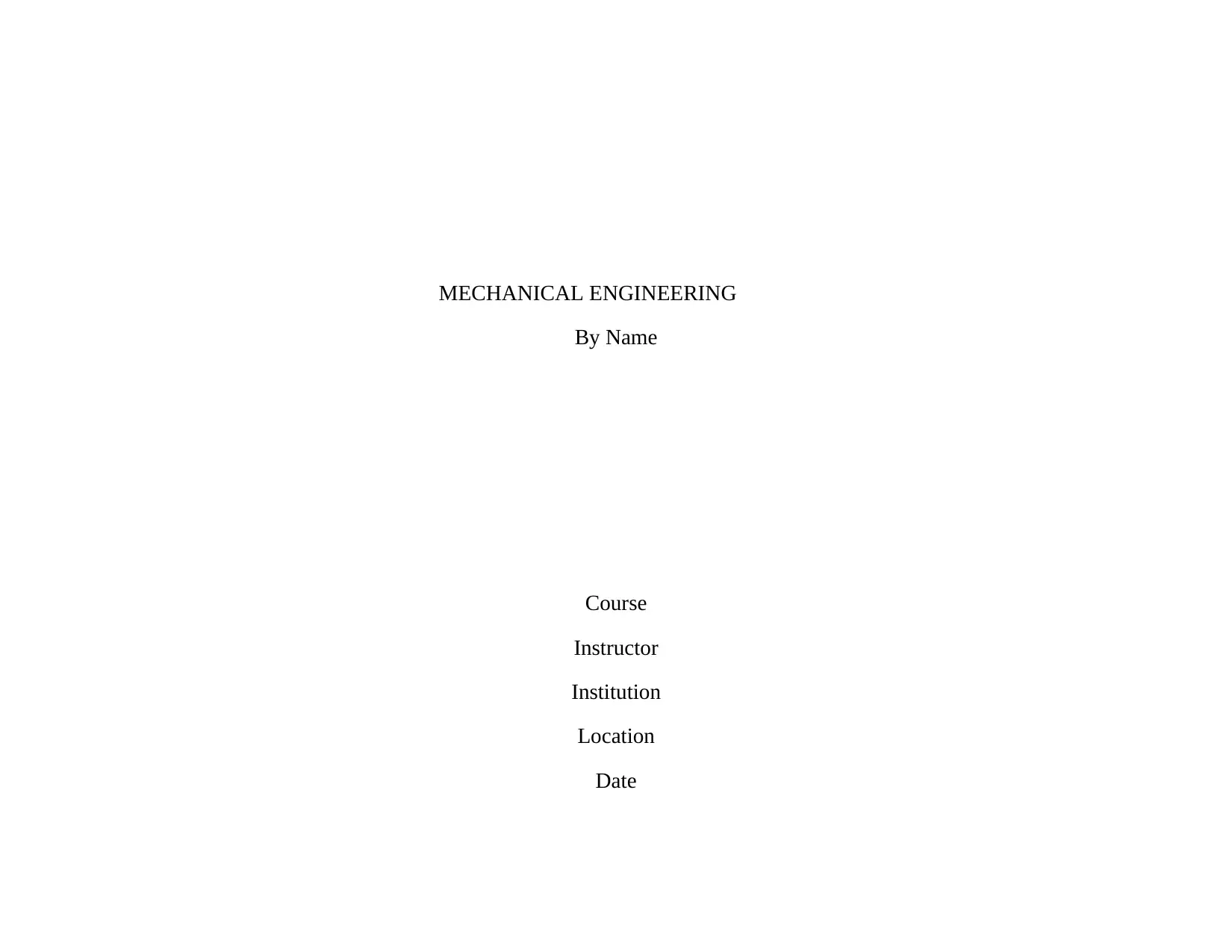
MECHANICAL ENGINEERING
By Name
Course
Instructor
Institution
Location
Date
By Name
Course
Instructor
Institution
Location
Date
Paraphrase This Document
Need a fresh take? Get an instant paraphrase of this document with our AI Paraphraser
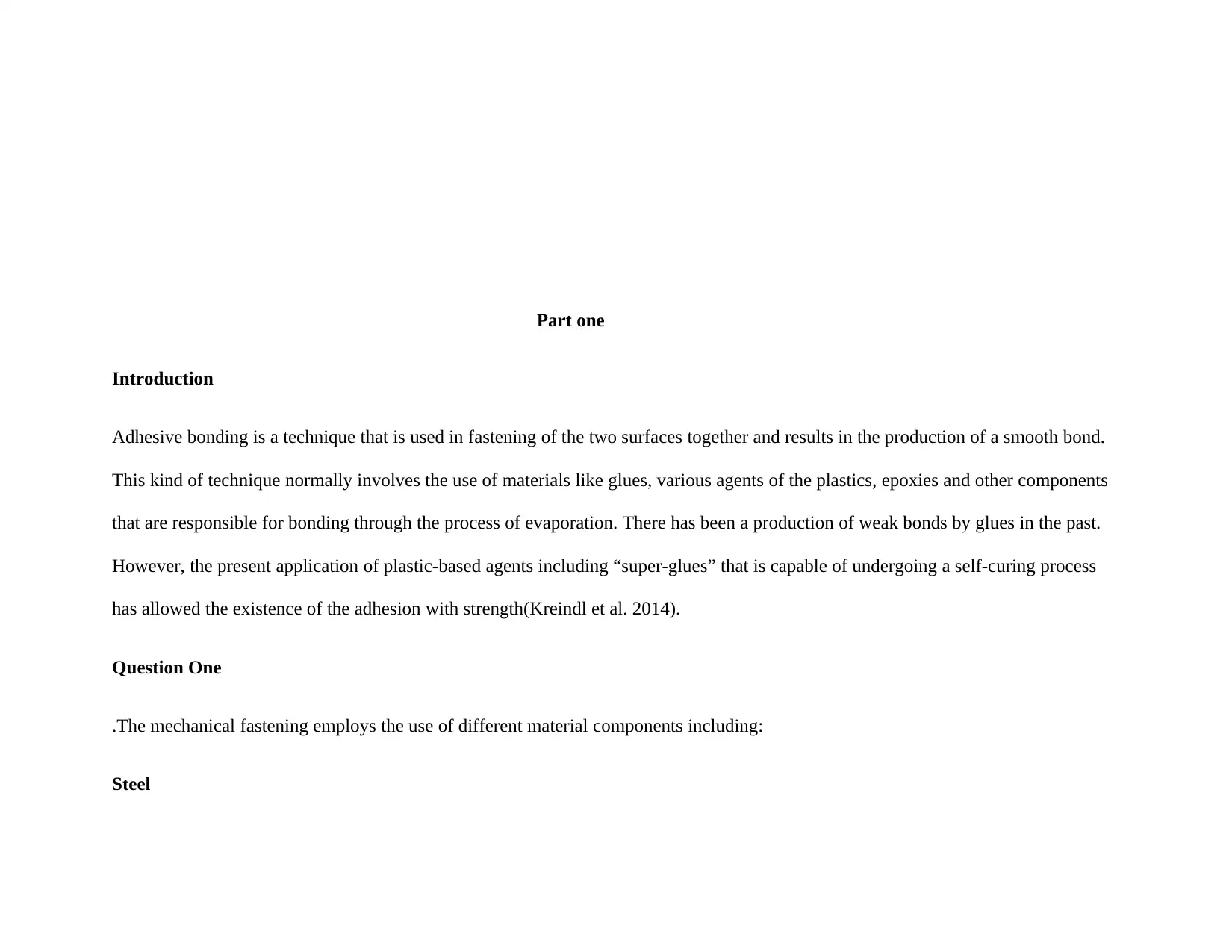
Part one
Introduction
Adhesive bonding is a technique that is used in fastening of the two surfaces together and results in the production of a smooth bond.
This kind of technique normally involves the use of materials like glues, various agents of the plastics, epoxies and other components
that are responsible for bonding through the process of evaporation. There has been a production of weak bonds by glues in the past.
However, the present application of plastic-based agents including “super-glues” that is capable of undergoing a self-curing process
has allowed the existence of the adhesion with strength(Kreindl et al. 2014).
Question One
.The mechanical fastening employs the use of different material components including:
Steel
Introduction
Adhesive bonding is a technique that is used in fastening of the two surfaces together and results in the production of a smooth bond.
This kind of technique normally involves the use of materials like glues, various agents of the plastics, epoxies and other components
that are responsible for bonding through the process of evaporation. There has been a production of weak bonds by glues in the past.
However, the present application of plastic-based agents including “super-glues” that is capable of undergoing a self-curing process
has allowed the existence of the adhesion with strength(Kreindl et al. 2014).
Question One
.The mechanical fastening employs the use of different material components including:
Steel
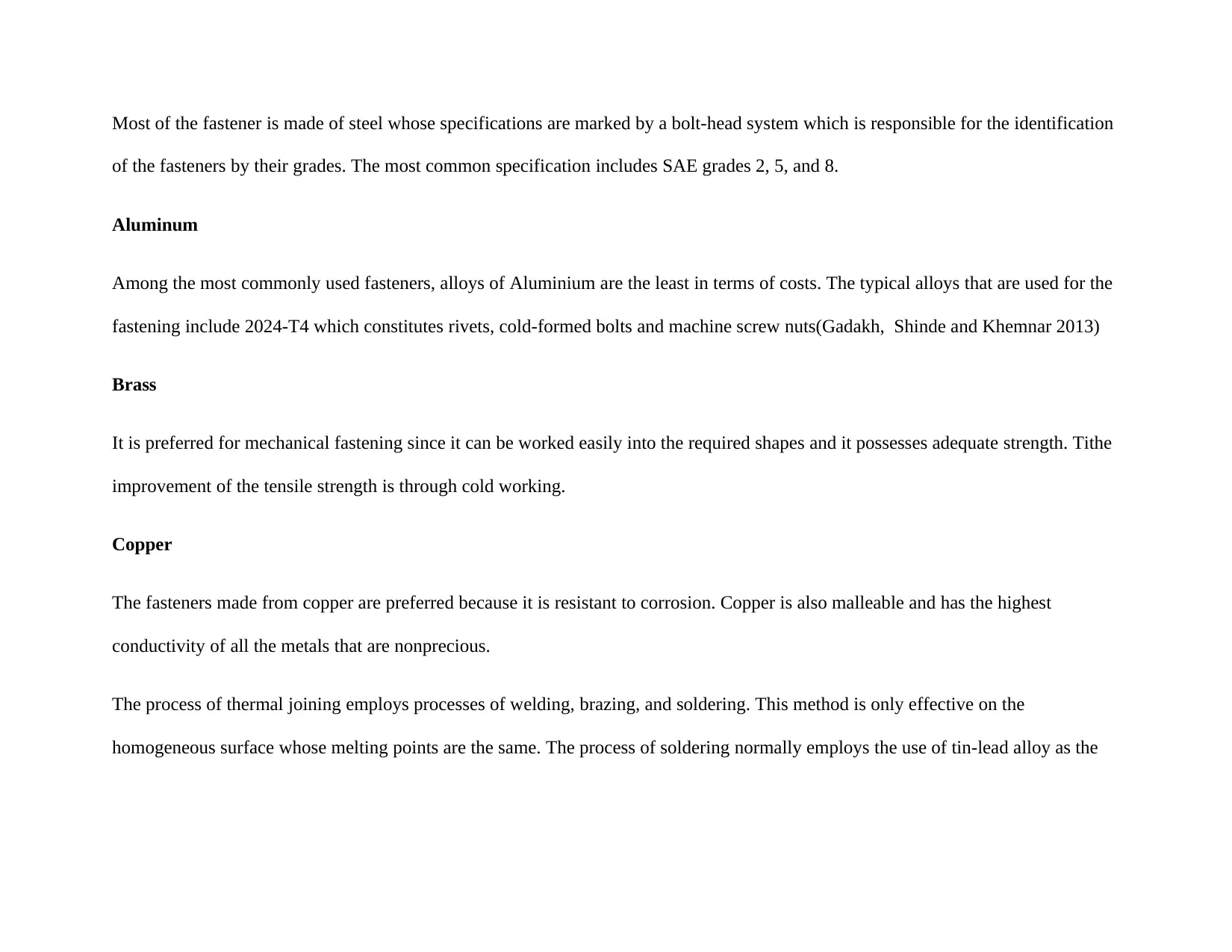
Most of the fastener is made of steel whose specifications are marked by a bolt-head system which is responsible for the identification
of the fasteners by their grades. The most common specification includes SAE grades 2, 5, and 8.
Aluminum
Among the most commonly used fasteners, alloys of Aluminium are the least in terms of costs. The typical alloys that are used for the
fastening include 2024-T4 which constitutes rivets, cold-formed bolts and machine screw nuts(Gadakh, Shinde and Khemnar 2013)
Brass
It is preferred for mechanical fastening since it can be worked easily into the required shapes and it possesses adequate strength. Tithe
improvement of the tensile strength is through cold working.
Copper
The fasteners made from copper are preferred because it is resistant to corrosion. Copper is also malleable and has the highest
conductivity of all the metals that are nonprecious.
The process of thermal joining employs processes of welding, brazing, and soldering. This method is only effective on the
homogeneous surface whose melting points are the same. The process of soldering normally employs the use of tin-lead alloy as the
of the fasteners by their grades. The most common specification includes SAE grades 2, 5, and 8.
Aluminum
Among the most commonly used fasteners, alloys of Aluminium are the least in terms of costs. The typical alloys that are used for the
fastening include 2024-T4 which constitutes rivets, cold-formed bolts and machine screw nuts(Gadakh, Shinde and Khemnar 2013)
Brass
It is preferred for mechanical fastening since it can be worked easily into the required shapes and it possesses adequate strength. Tithe
improvement of the tensile strength is through cold working.
Copper
The fasteners made from copper are preferred because it is resistant to corrosion. Copper is also malleable and has the highest
conductivity of all the metals that are nonprecious.
The process of thermal joining employs processes of welding, brazing, and soldering. This method is only effective on the
homogeneous surface whose melting points are the same. The process of soldering normally employs the use of tin-lead alloy as the
⊘ This is a preview!⊘
Do you want full access?
Subscribe today to unlock all pages.

Trusted by 1+ million students worldwide
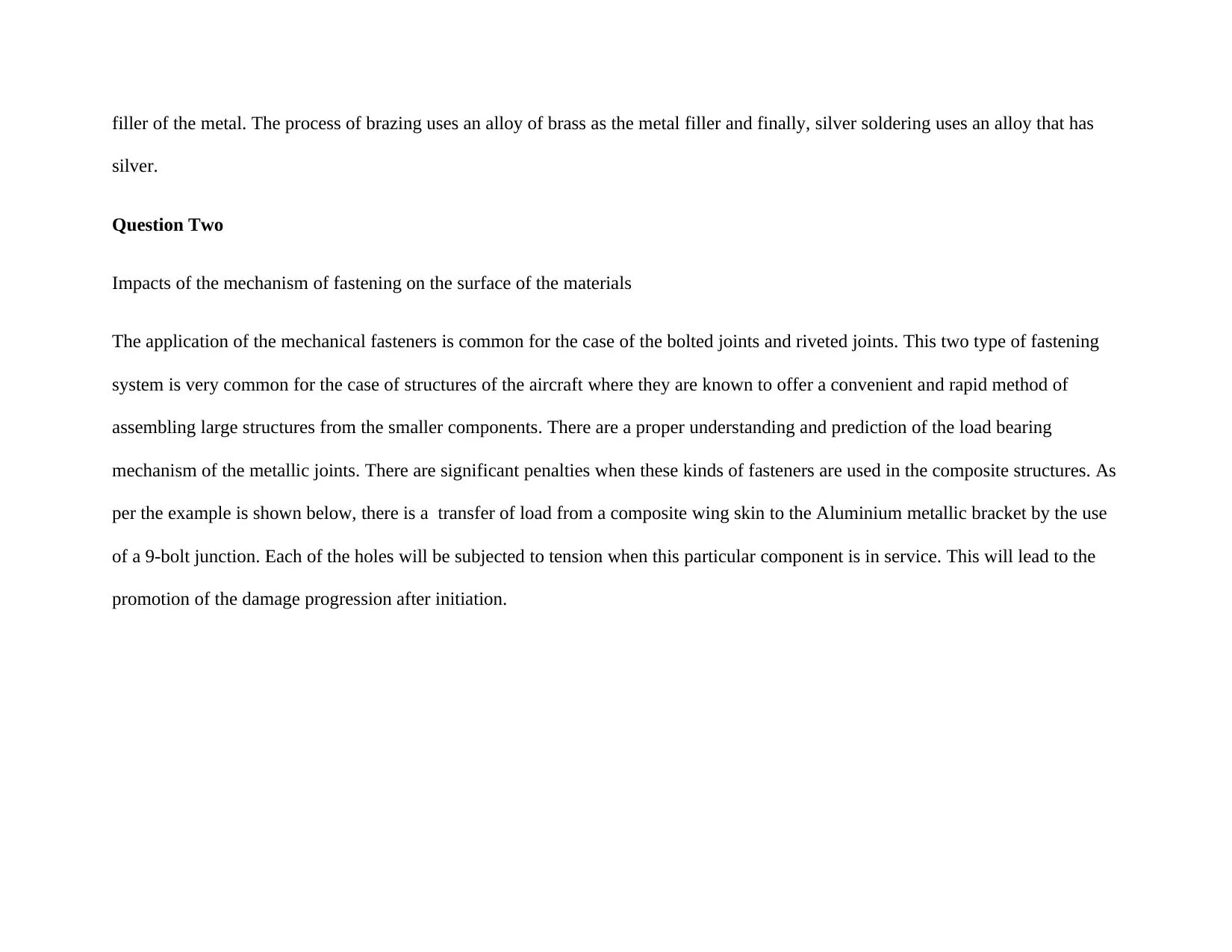
filler of the metal. The process of brazing uses an alloy of brass as the metal filler and finally, silver soldering uses an alloy that has
silver.
Question Two
Impacts of the mechanism of fastening on the surface of the materials
The application of the mechanical fasteners is common for the case of the bolted joints and riveted joints. This two type of fastening
system is very common for the case of structures of the aircraft where they are known to offer a convenient and rapid method of
assembling large structures from the smaller components. There are a proper understanding and prediction of the load bearing
mechanism of the metallic joints. There are significant penalties when these kinds of fasteners are used in the composite structures. As
per the example is shown below, there is a transfer of load from a composite wing skin to the Aluminium metallic bracket by the use
of a 9-bolt junction. Each of the holes will be subjected to tension when this particular component is in service. This will lead to the
promotion of the damage progression after initiation.
silver.
Question Two
Impacts of the mechanism of fastening on the surface of the materials
The application of the mechanical fasteners is common for the case of the bolted joints and riveted joints. This two type of fastening
system is very common for the case of structures of the aircraft where they are known to offer a convenient and rapid method of
assembling large structures from the smaller components. There are a proper understanding and prediction of the load bearing
mechanism of the metallic joints. There are significant penalties when these kinds of fasteners are used in the composite structures. As
per the example is shown below, there is a transfer of load from a composite wing skin to the Aluminium metallic bracket by the use
of a 9-bolt junction. Each of the holes will be subjected to tension when this particular component is in service. This will lead to the
promotion of the damage progression after initiation.
Paraphrase This Document
Need a fresh take? Get an instant paraphrase of this document with our AI Paraphraser
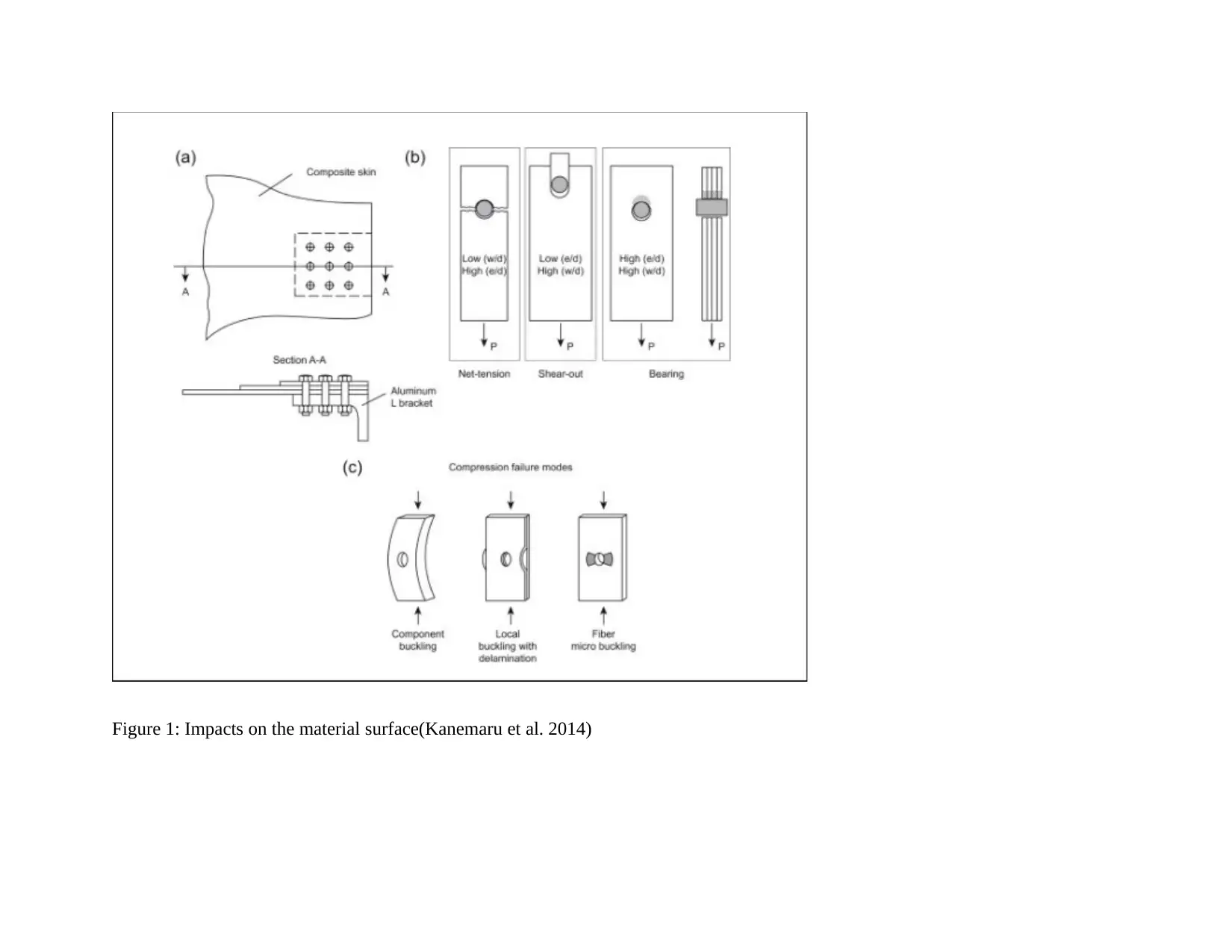
Figure 1: Impacts on the material surface(Kanemaru et al. 2014)
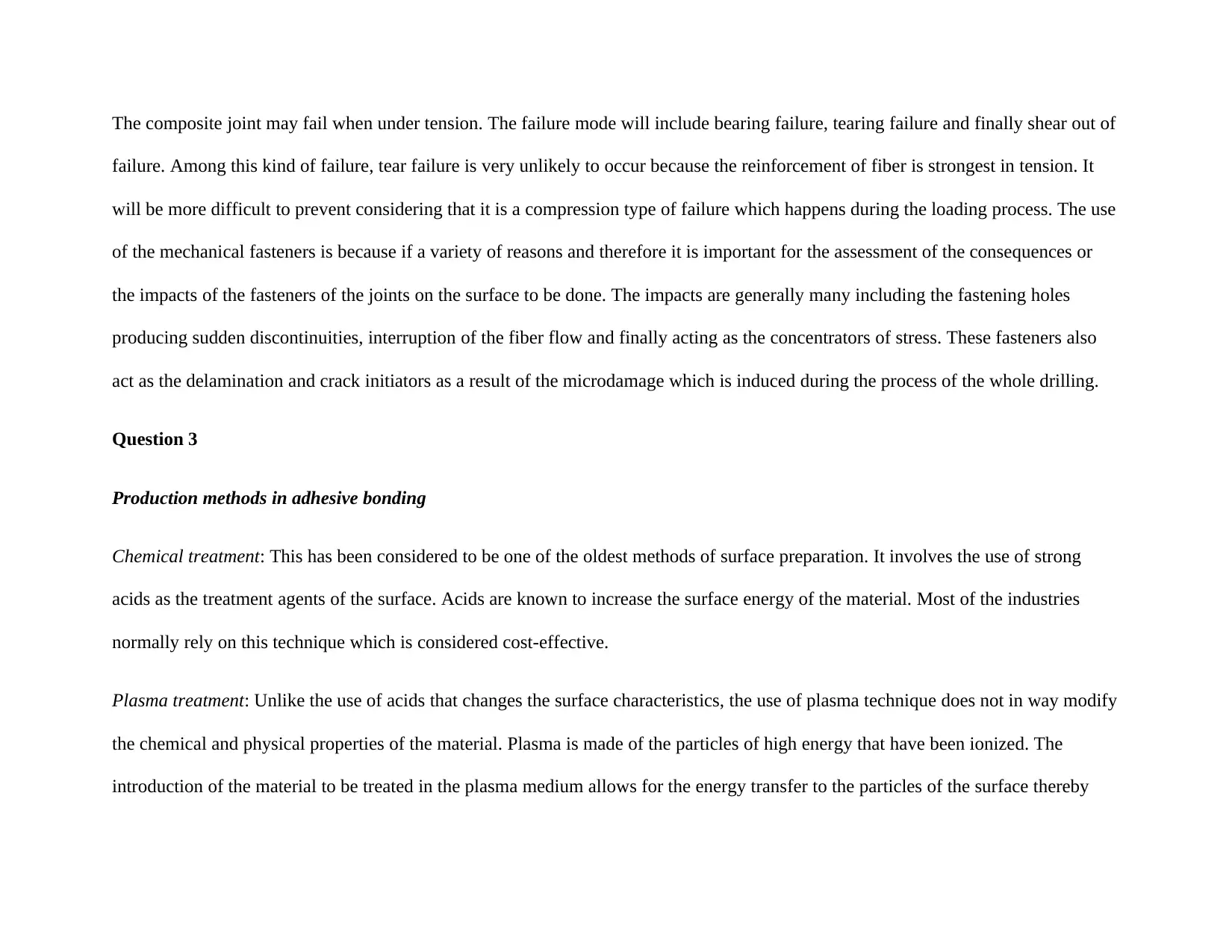
The composite joint may fail when under tension. The failure mode will include bearing failure, tearing failure and finally shear out of
failure. Among this kind of failure, tear failure is very unlikely to occur because the reinforcement of fiber is strongest in tension. It
will be more difficult to prevent considering that it is a compression type of failure which happens during the loading process. The use
of the mechanical fasteners is because if a variety of reasons and therefore it is important for the assessment of the consequences or
the impacts of the fasteners of the joints on the surface to be done. The impacts are generally many including the fastening holes
producing sudden discontinuities, interruption of the fiber flow and finally acting as the concentrators of stress. These fasteners also
act as the delamination and crack initiators as a result of the microdamage which is induced during the process of the whole drilling.
Question 3
Production methods in adhesive bonding
Chemical treatment: This has been considered to be one of the oldest methods of surface preparation. It involves the use of strong
acids as the treatment agents of the surface. Acids are known to increase the surface energy of the material. Most of the industries
normally rely on this technique which is considered cost-effective.
Plasma treatment: Unlike the use of acids that changes the surface characteristics, the use of plasma technique does not in way modify
the chemical and physical properties of the material. Plasma is made of the particles of high energy that have been ionized. The
introduction of the material to be treated in the plasma medium allows for the energy transfer to the particles of the surface thereby
failure. Among this kind of failure, tear failure is very unlikely to occur because the reinforcement of fiber is strongest in tension. It
will be more difficult to prevent considering that it is a compression type of failure which happens during the loading process. The use
of the mechanical fasteners is because if a variety of reasons and therefore it is important for the assessment of the consequences or
the impacts of the fasteners of the joints on the surface to be done. The impacts are generally many including the fastening holes
producing sudden discontinuities, interruption of the fiber flow and finally acting as the concentrators of stress. These fasteners also
act as the delamination and crack initiators as a result of the microdamage which is induced during the process of the whole drilling.
Question 3
Production methods in adhesive bonding
Chemical treatment: This has been considered to be one of the oldest methods of surface preparation. It involves the use of strong
acids as the treatment agents of the surface. Acids are known to increase the surface energy of the material. Most of the industries
normally rely on this technique which is considered cost-effective.
Plasma treatment: Unlike the use of acids that changes the surface characteristics, the use of plasma technique does not in way modify
the chemical and physical properties of the material. Plasma is made of the particles of high energy that have been ionized. The
introduction of the material to be treated in the plasma medium allows for the energy transfer to the particles of the surface thereby
⊘ This is a preview!⊘
Do you want full access?
Subscribe today to unlock all pages.

Trusted by 1+ million students worldwide
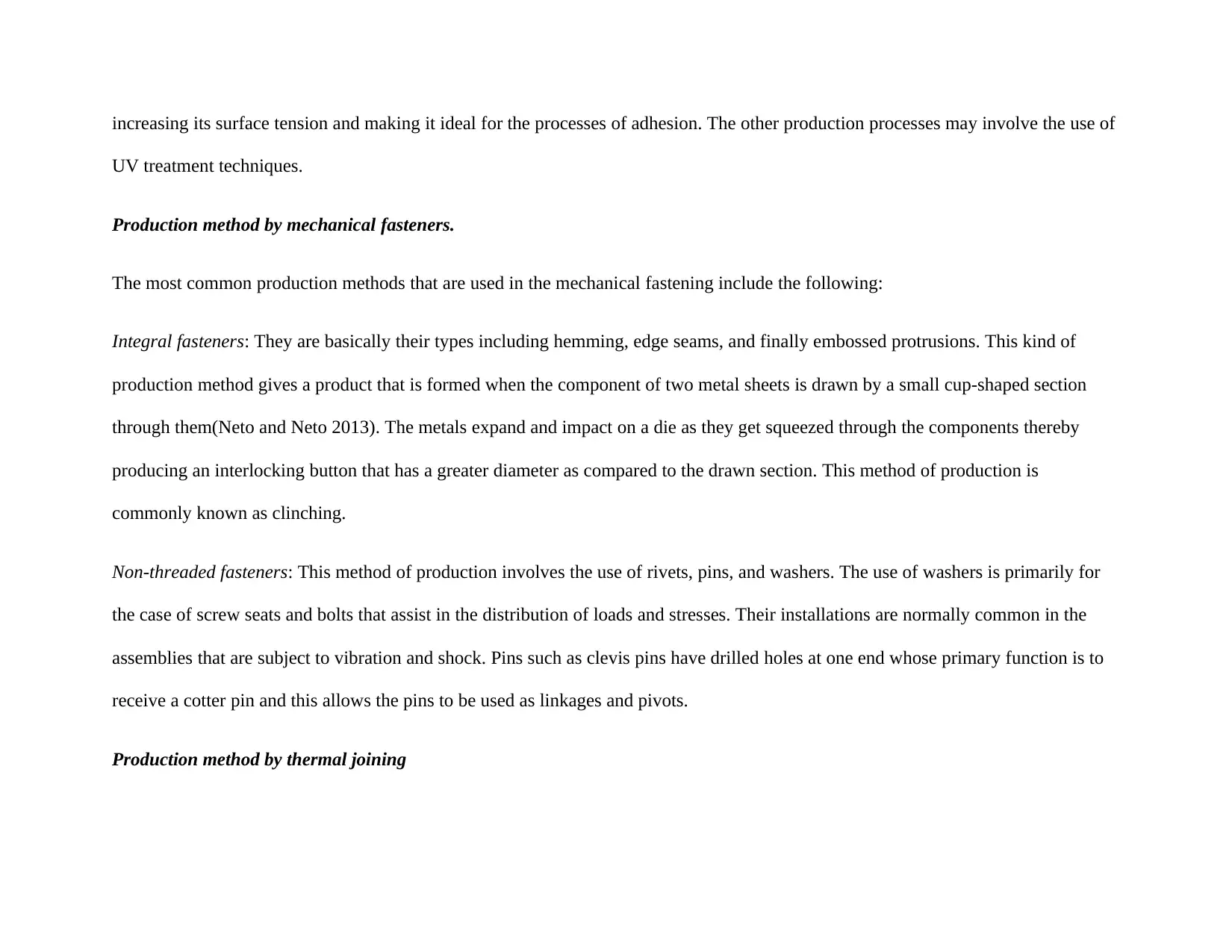
increasing its surface tension and making it ideal for the processes of adhesion. The other production processes may involve the use of
UV treatment techniques.
Production method by mechanical fasteners.
The most common production methods that are used in the mechanical fastening include the following:
Integral fasteners: They are basically their types including hemming, edge seams, and finally embossed protrusions. This kind of
production method gives a product that is formed when the component of two metal sheets is drawn by a small cup-shaped section
through them(Neto and Neto 2013). The metals expand and impact on a die as they get squeezed through the components thereby
producing an interlocking button that has a greater diameter as compared to the drawn section. This method of production is
commonly known as clinching.
Non-threaded fasteners: This method of production involves the use of rivets, pins, and washers. The use of washers is primarily for
the case of screw seats and bolts that assist in the distribution of loads and stresses. Their installations are normally common in the
assemblies that are subject to vibration and shock. Pins such as clevis pins have drilled holes at one end whose primary function is to
receive a cotter pin and this allows the pins to be used as linkages and pivots.
Production method by thermal joining
UV treatment techniques.
Production method by mechanical fasteners.
The most common production methods that are used in the mechanical fastening include the following:
Integral fasteners: They are basically their types including hemming, edge seams, and finally embossed protrusions. This kind of
production method gives a product that is formed when the component of two metal sheets is drawn by a small cup-shaped section
through them(Neto and Neto 2013). The metals expand and impact on a die as they get squeezed through the components thereby
producing an interlocking button that has a greater diameter as compared to the drawn section. This method of production is
commonly known as clinching.
Non-threaded fasteners: This method of production involves the use of rivets, pins, and washers. The use of washers is primarily for
the case of screw seats and bolts that assist in the distribution of loads and stresses. Their installations are normally common in the
assemblies that are subject to vibration and shock. Pins such as clevis pins have drilled holes at one end whose primary function is to
receive a cotter pin and this allows the pins to be used as linkages and pivots.
Production method by thermal joining
Paraphrase This Document
Need a fresh take? Get an instant paraphrase of this document with our AI Paraphraser
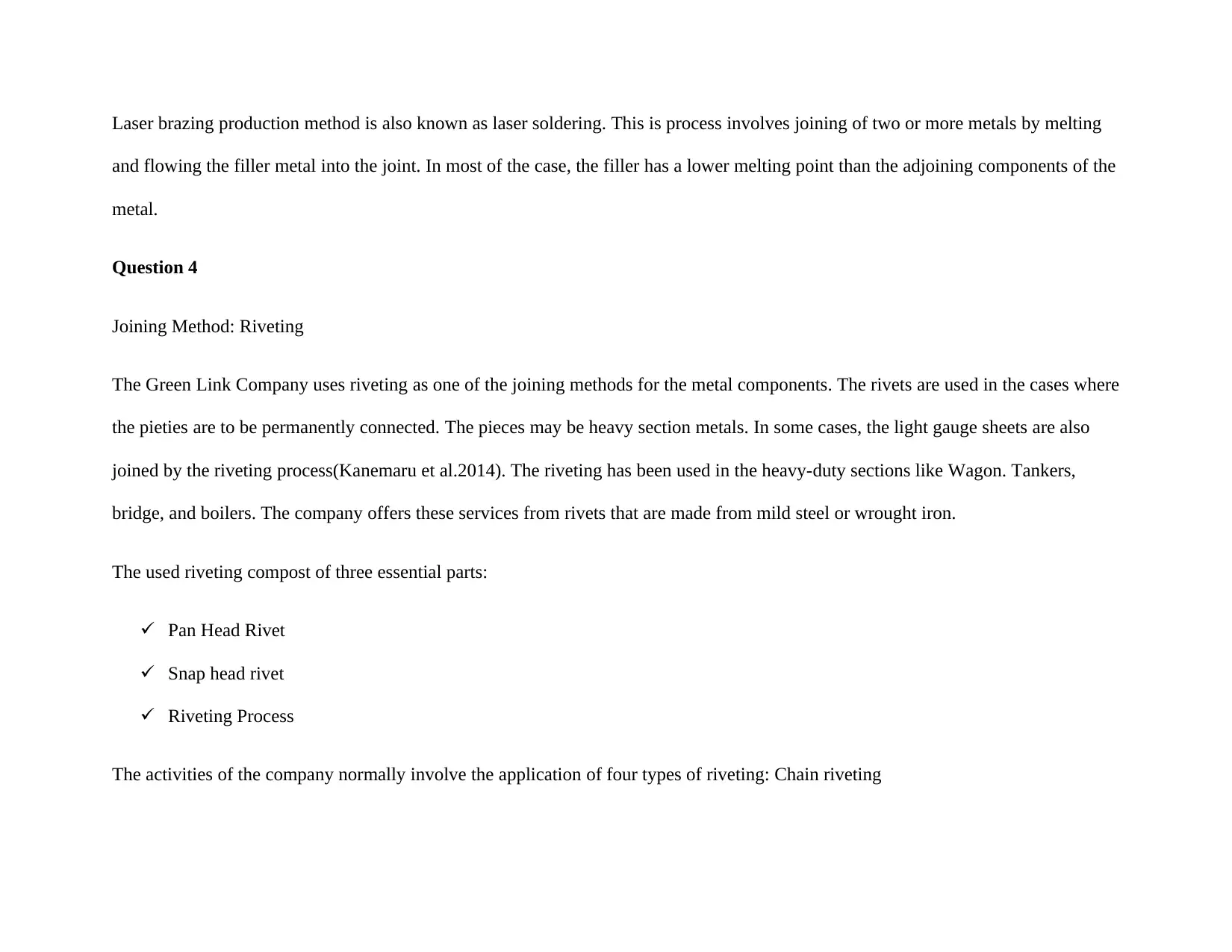
Laser brazing production method is also known as laser soldering. This is process involves joining of two or more metals by melting
and flowing the filler metal into the joint. In most of the case, the filler has a lower melting point than the adjoining components of the
metal.
Question 4
Joining Method: Riveting
The Green Link Company uses riveting as one of the joining methods for the metal components. The rivets are used in the cases where
the pieties are to be permanently connected. The pieces may be heavy section metals. In some cases, the light gauge sheets are also
joined by the riveting process(Kanemaru et al.2014). The riveting has been used in the heavy-duty sections like Wagon. Tankers,
bridge, and boilers. The company offers these services from rivets that are made from mild steel or wrought iron.
The used riveting compost of three essential parts:
Pan Head Rivet
Snap head rivet
Riveting Process
The activities of the company normally involve the application of four types of riveting: Chain riveting
and flowing the filler metal into the joint. In most of the case, the filler has a lower melting point than the adjoining components of the
metal.
Question 4
Joining Method: Riveting
The Green Link Company uses riveting as one of the joining methods for the metal components. The rivets are used in the cases where
the pieties are to be permanently connected. The pieces may be heavy section metals. In some cases, the light gauge sheets are also
joined by the riveting process(Kanemaru et al.2014). The riveting has been used in the heavy-duty sections like Wagon. Tankers,
bridge, and boilers. The company offers these services from rivets that are made from mild steel or wrought iron.
The used riveting compost of three essential parts:
Pan Head Rivet
Snap head rivet
Riveting Process
The activities of the company normally involve the application of four types of riveting: Chain riveting
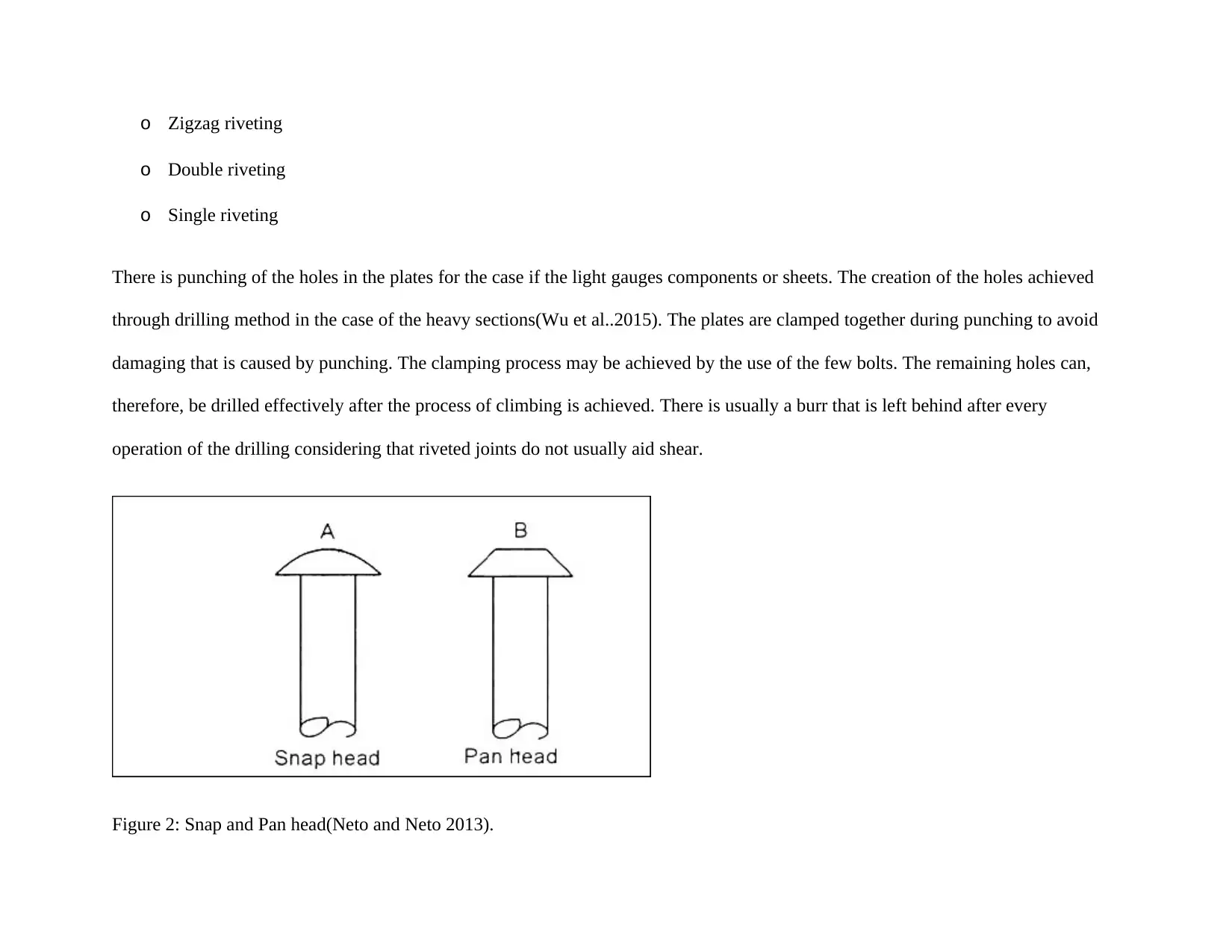
o Zigzag riveting
o Double riveting
o Single riveting
There is punching of the holes in the plates for the case if the light gauges components or sheets. The creation of the holes achieved
through drilling method in the case of the heavy sections(Wu et al..2015). The plates are clamped together during punching to avoid
damaging that is caused by punching. The clamping process may be achieved by the use of the few bolts. The remaining holes can,
therefore, be drilled effectively after the process of climbing is achieved. There is usually a burr that is left behind after every
operation of the drilling considering that riveted joints do not usually aid shear.
Figure 2: Snap and Pan head(Neto and Neto 2013).
o Double riveting
o Single riveting
There is punching of the holes in the plates for the case if the light gauges components or sheets. The creation of the holes achieved
through drilling method in the case of the heavy sections(Wu et al..2015). The plates are clamped together during punching to avoid
damaging that is caused by punching. The clamping process may be achieved by the use of the few bolts. The remaining holes can,
therefore, be drilled effectively after the process of climbing is achieved. There is usually a burr that is left behind after every
operation of the drilling considering that riveted joints do not usually aid shear.
Figure 2: Snap and Pan head(Neto and Neto 2013).
⊘ This is a preview!⊘
Do you want full access?
Subscribe today to unlock all pages.

Trusted by 1+ million students worldwide
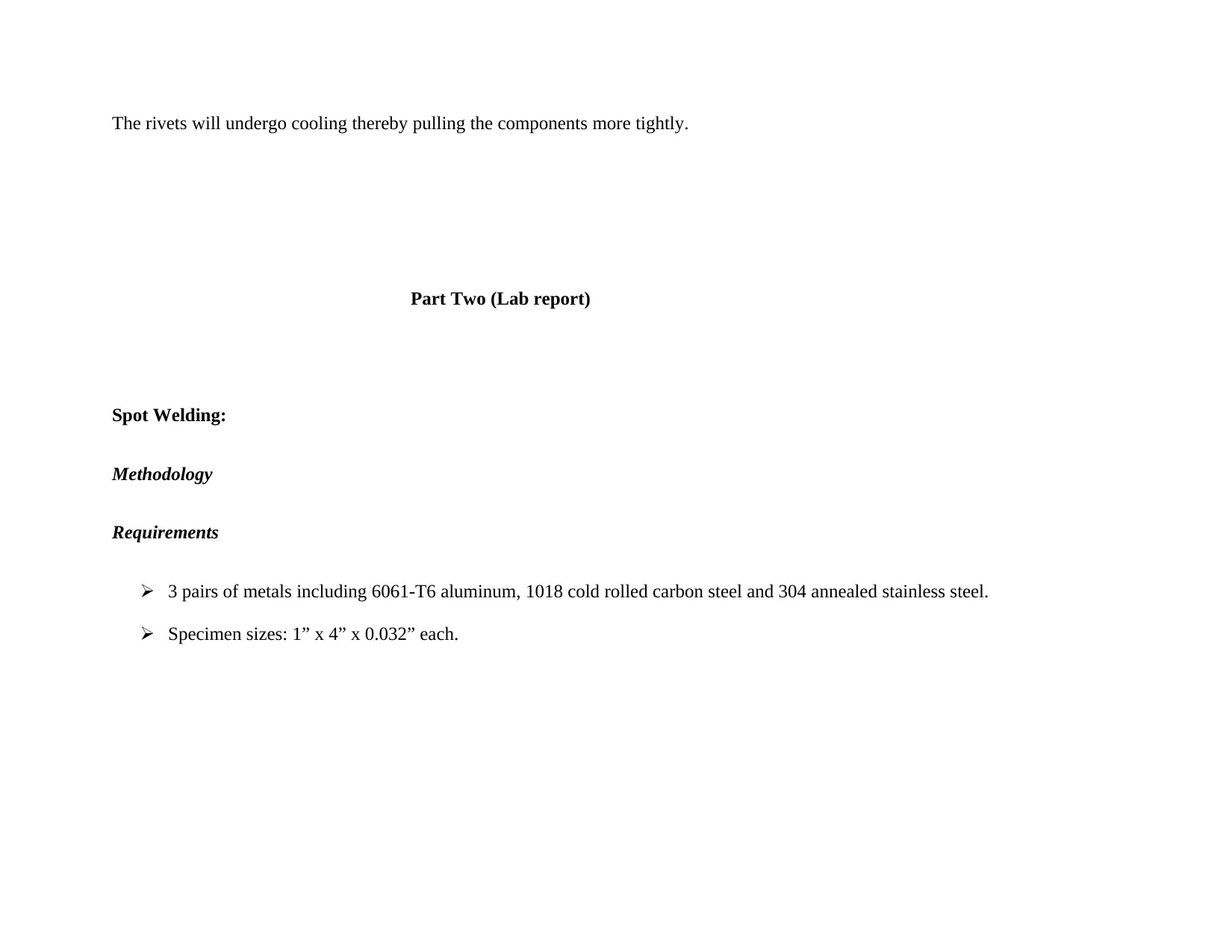
The rivets will undergo cooling thereby pulling the components more tightly.
Part Two (Lab report)
Spot Welding:
Methodology
Requirements
3 pairs of metals including 6061-T6 aluminum, 1018 cold rolled carbon steel and 304 annealed stainless steel.
Specimen sizes: 1” x 4” x 0.032” each.
Part Two (Lab report)
Spot Welding:
Methodology
Requirements
3 pairs of metals including 6061-T6 aluminum, 1018 cold rolled carbon steel and 304 annealed stainless steel.
Specimen sizes: 1” x 4” x 0.032” each.
Paraphrase This Document
Need a fresh take? Get an instant paraphrase of this document with our AI Paraphraser
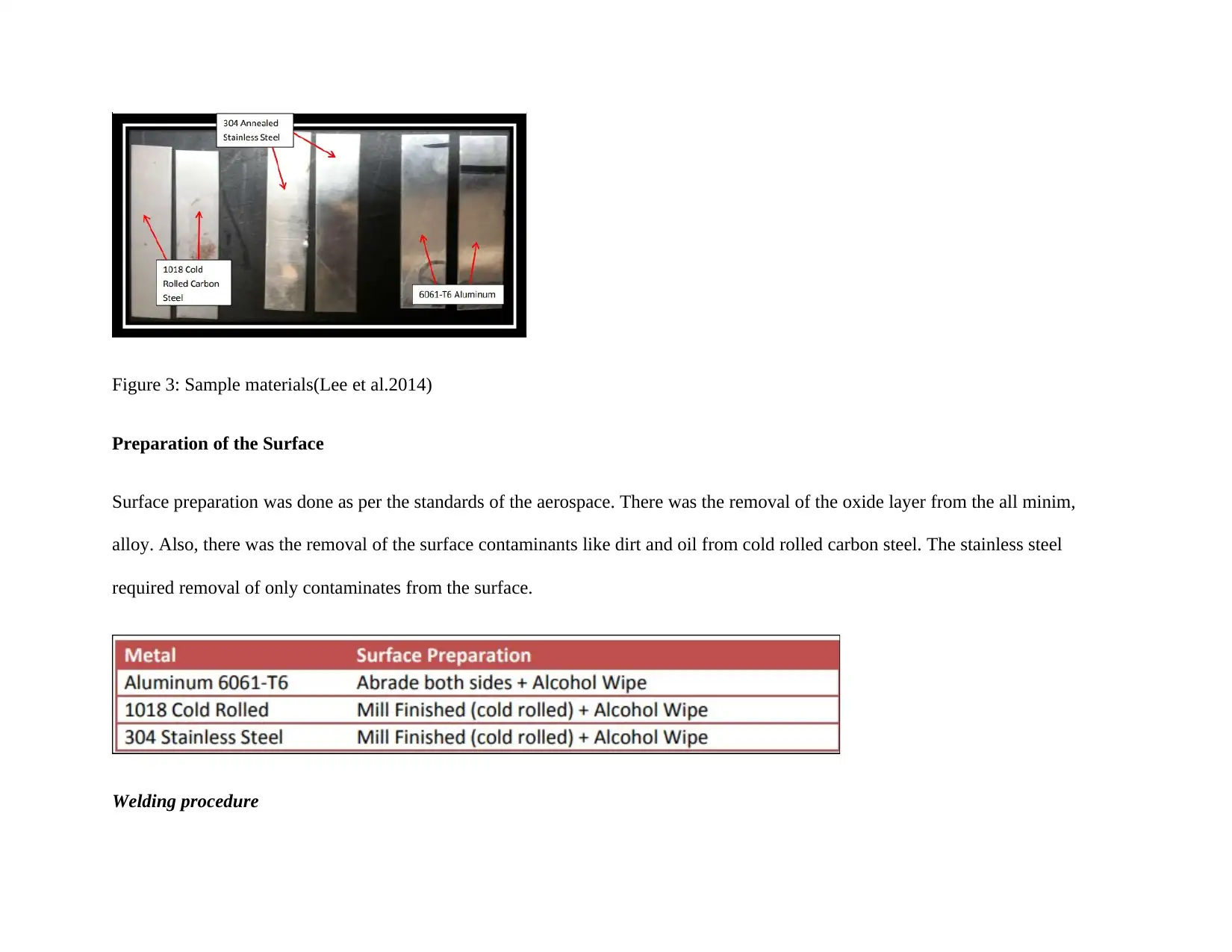
Figure 3: Sample materials(Lee et al.2014)
Preparation of the Surface
Surface preparation was done as per the standards of the aerospace. There was the removal of the oxide layer from the all minim,
alloy. Also, there was the removal of the surface contaminants like dirt and oil from cold rolled carbon steel. The stainless steel
required removal of only contaminates from the surface.
Welding procedure
Preparation of the Surface
Surface preparation was done as per the standards of the aerospace. There was the removal of the oxide layer from the all minim,
alloy. Also, there was the removal of the surface contaminants like dirt and oil from cold rolled carbon steel. The stainless steel
required removal of only contaminates from the surface.
Welding procedure
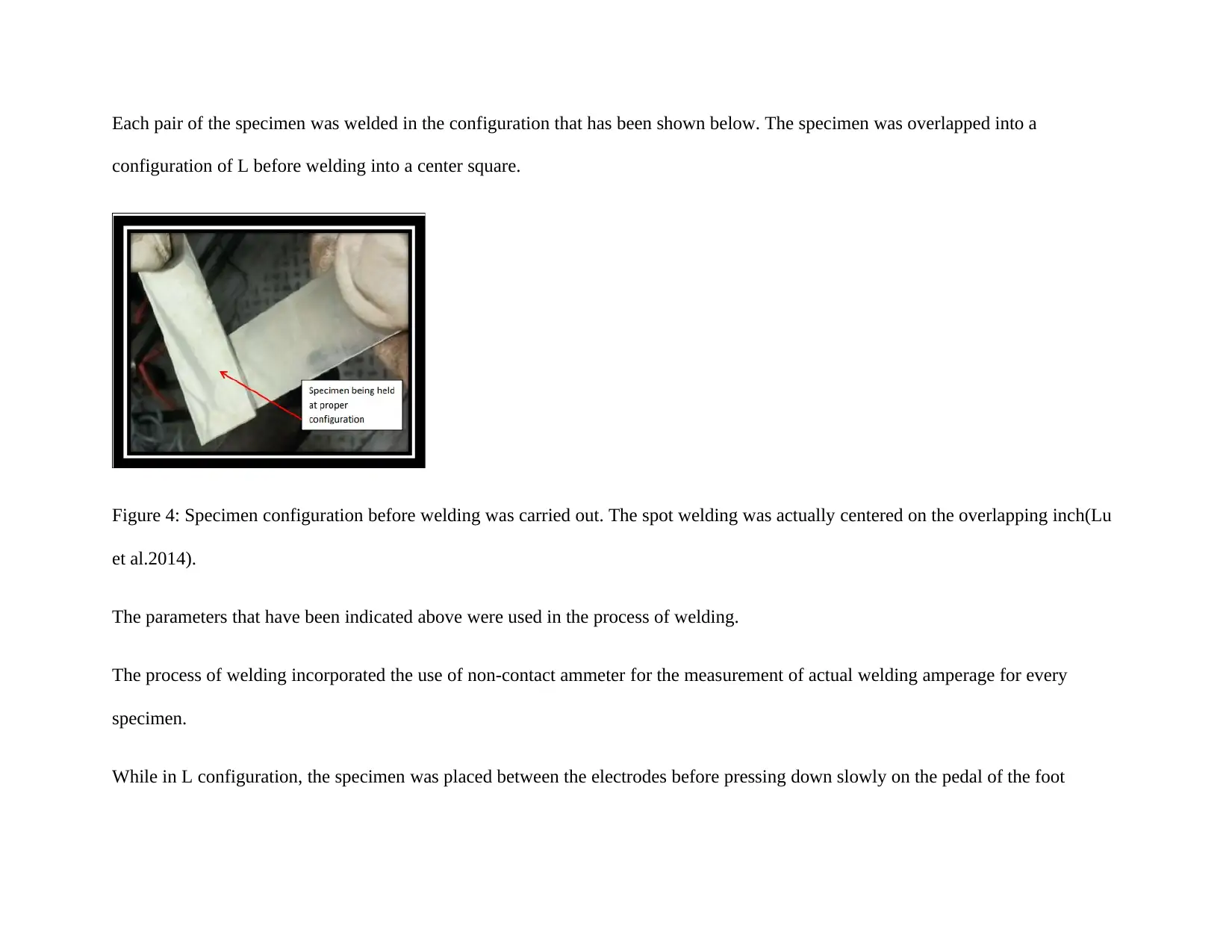
Each pair of the specimen was welded in the configuration that has been shown below. The specimen was overlapped into a
configuration of L before welding into a center square.
Figure 4: Specimen configuration before welding was carried out. The spot welding was actually centered on the overlapping inch(Lu
et al.2014).
The parameters that have been indicated above were used in the process of welding.
The process of welding incorporated the use of non-contact ammeter for the measurement of actual welding amperage for every
specimen.
While in L configuration, the specimen was placed between the electrodes before pressing down slowly on the pedal of the foot
configuration of L before welding into a center square.
Figure 4: Specimen configuration before welding was carried out. The spot welding was actually centered on the overlapping inch(Lu
et al.2014).
The parameters that have been indicated above were used in the process of welding.
The process of welding incorporated the use of non-contact ammeter for the measurement of actual welding amperage for every
specimen.
While in L configuration, the specimen was placed between the electrodes before pressing down slowly on the pedal of the foot
⊘ This is a preview!⊘
Do you want full access?
Subscribe today to unlock all pages.

Trusted by 1+ million students worldwide
1 out of 30
Related Documents
Your All-in-One AI-Powered Toolkit for Academic Success.
+13062052269
info@desklib.com
Available 24*7 on WhatsApp / Email
![[object Object]](/_next/static/media/star-bottom.7253800d.svg)
Unlock your academic potential
Copyright © 2020–2025 A2Z Services. All Rights Reserved. Developed and managed by ZUCOL.




